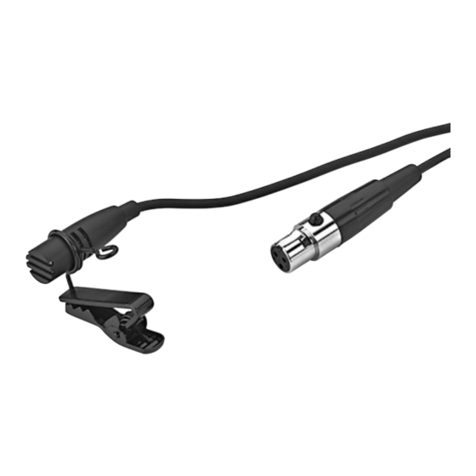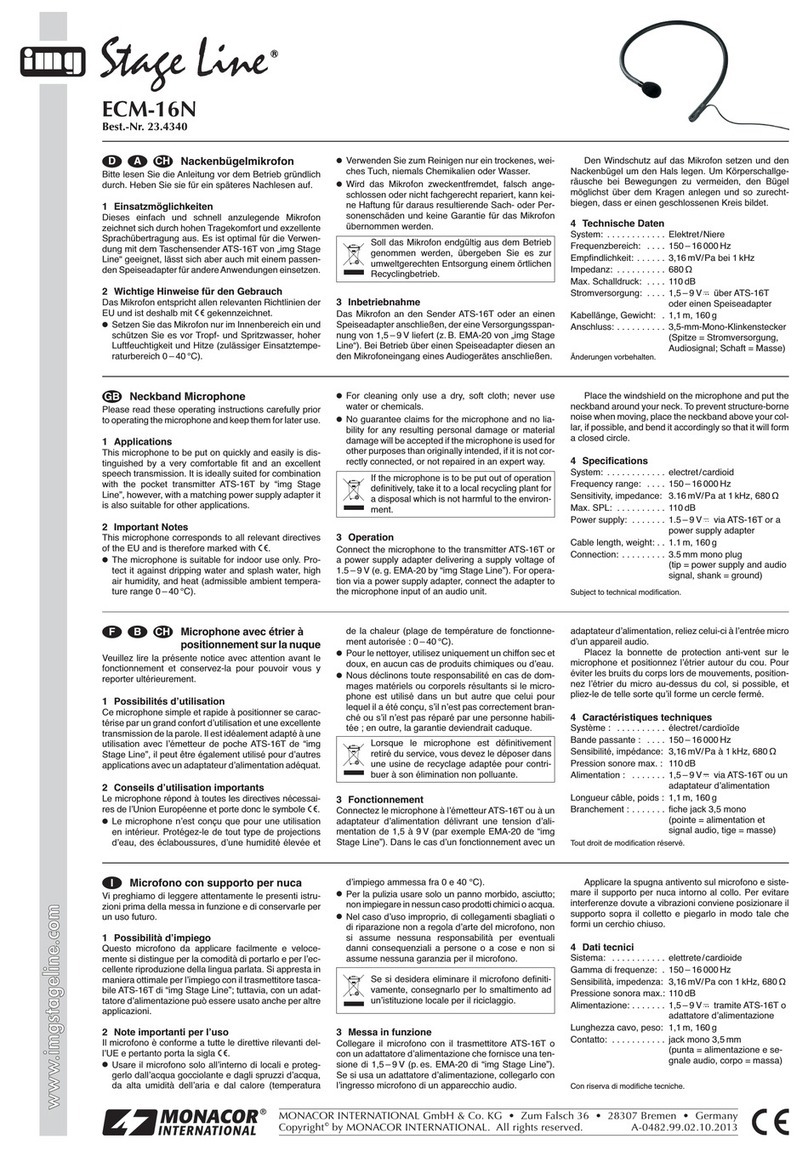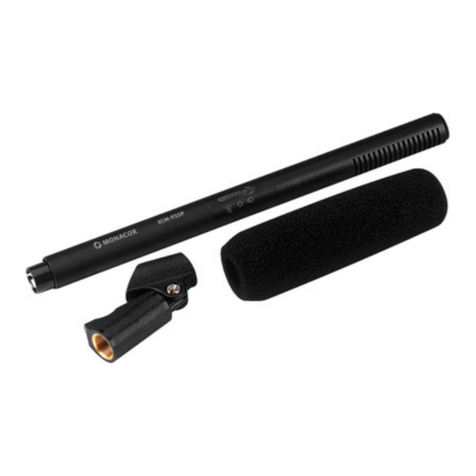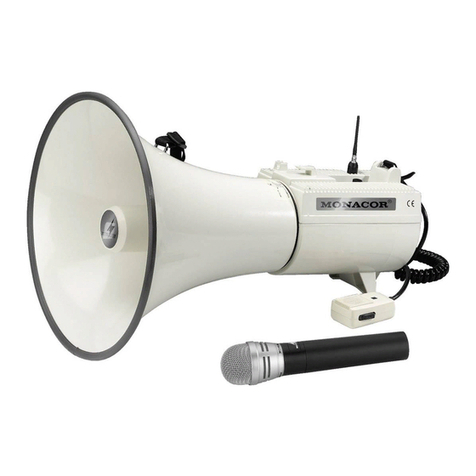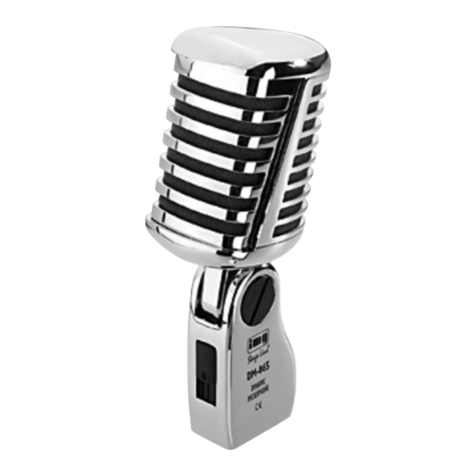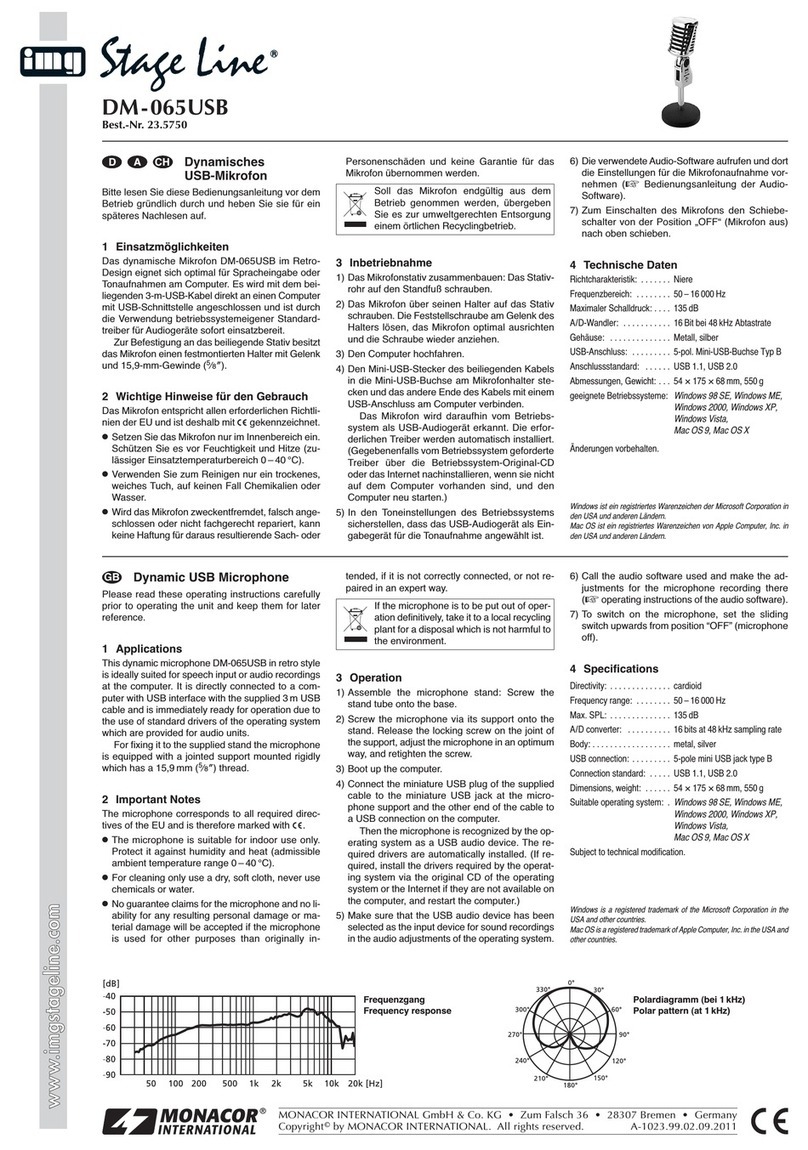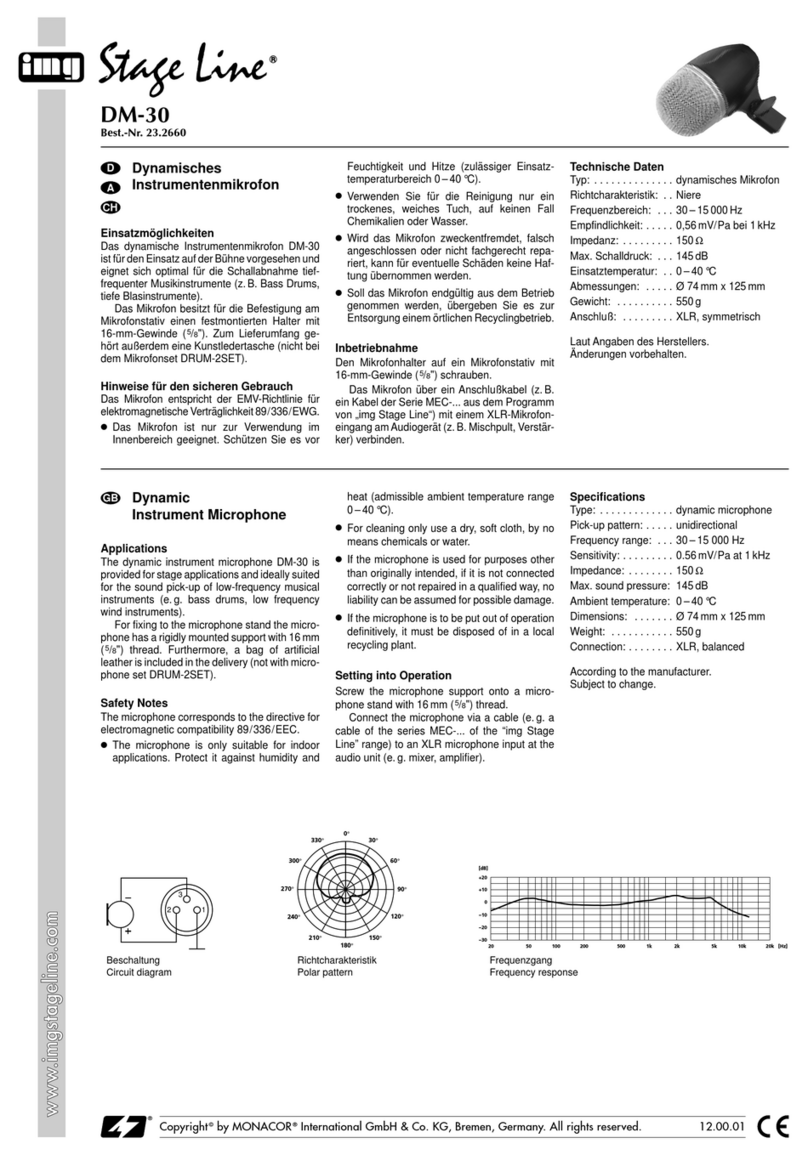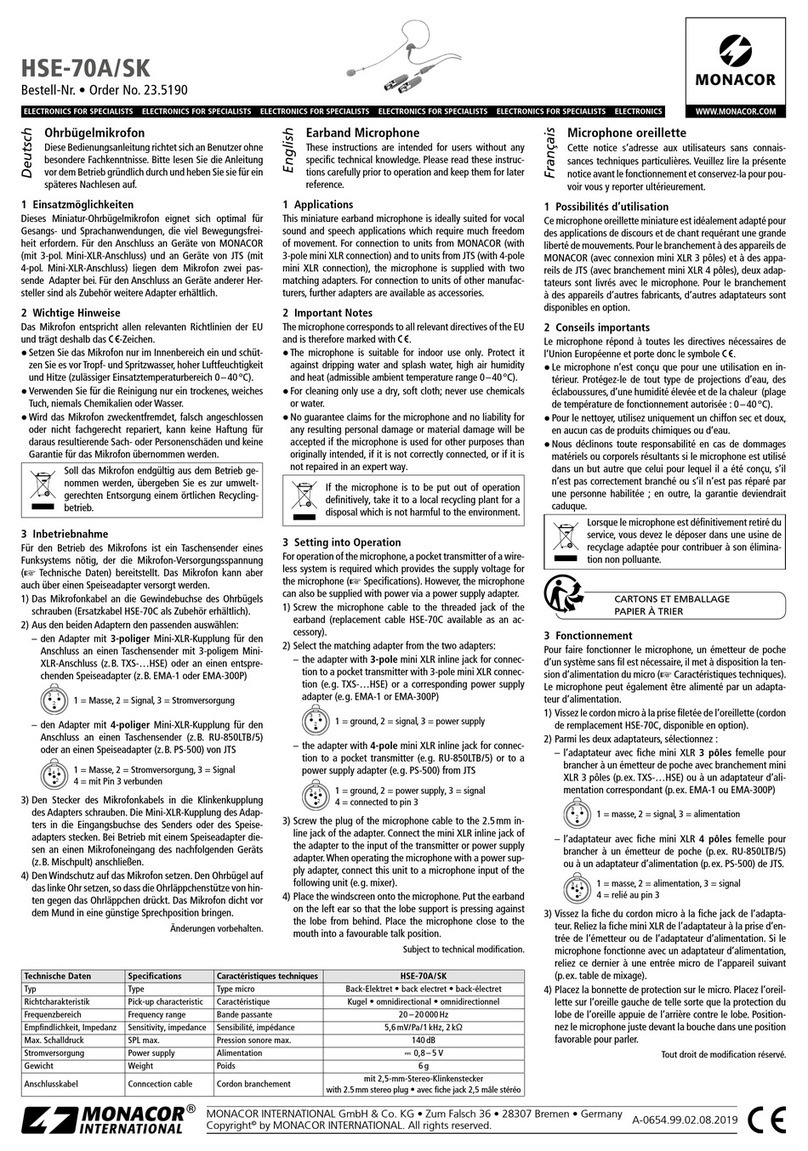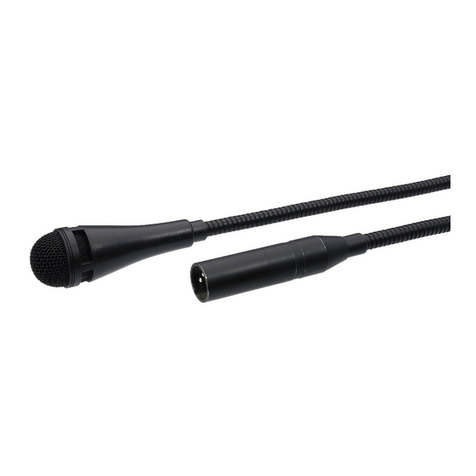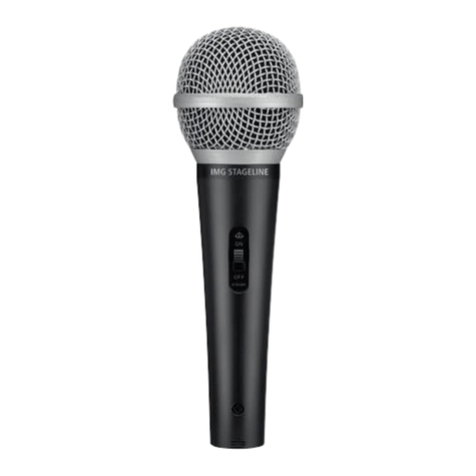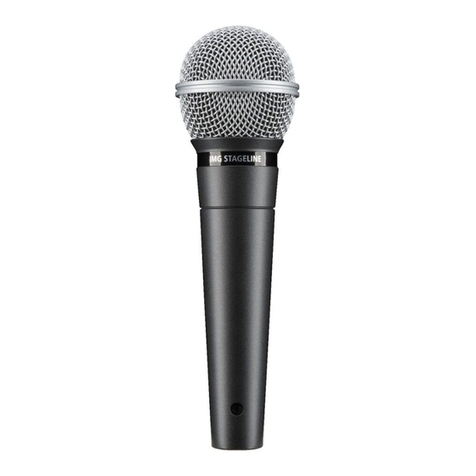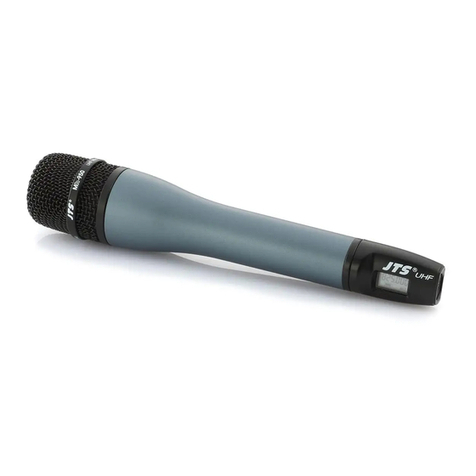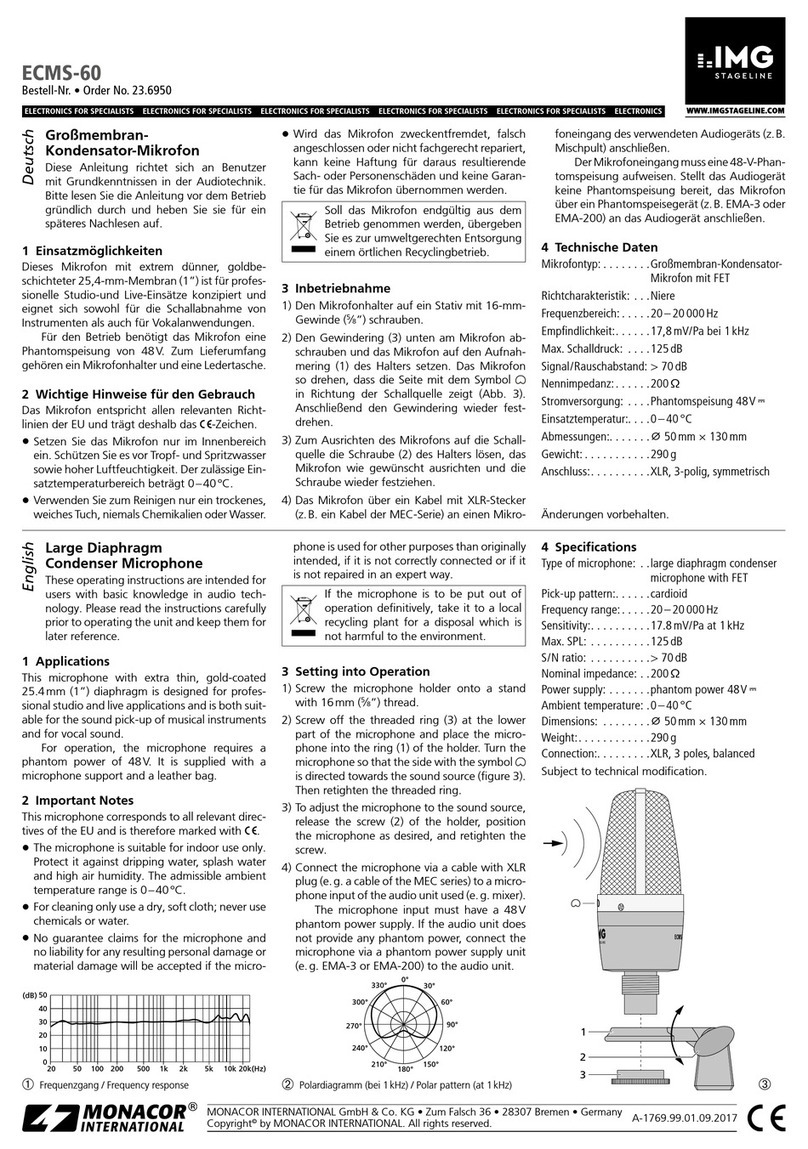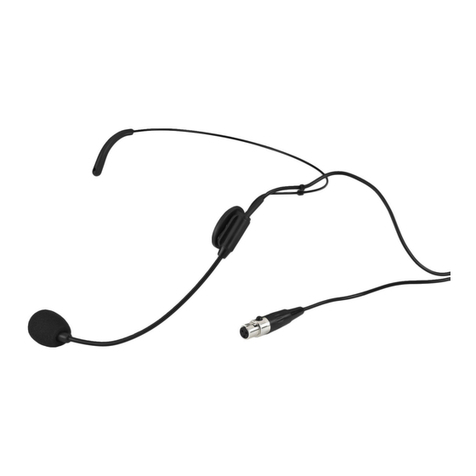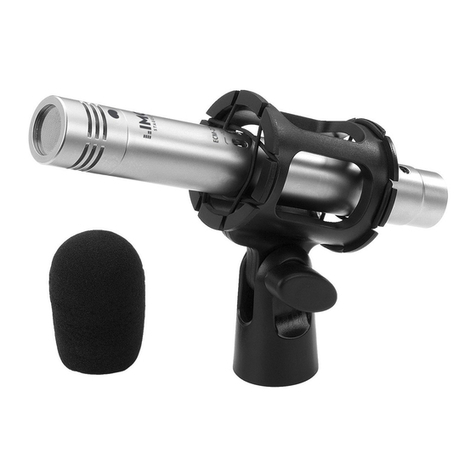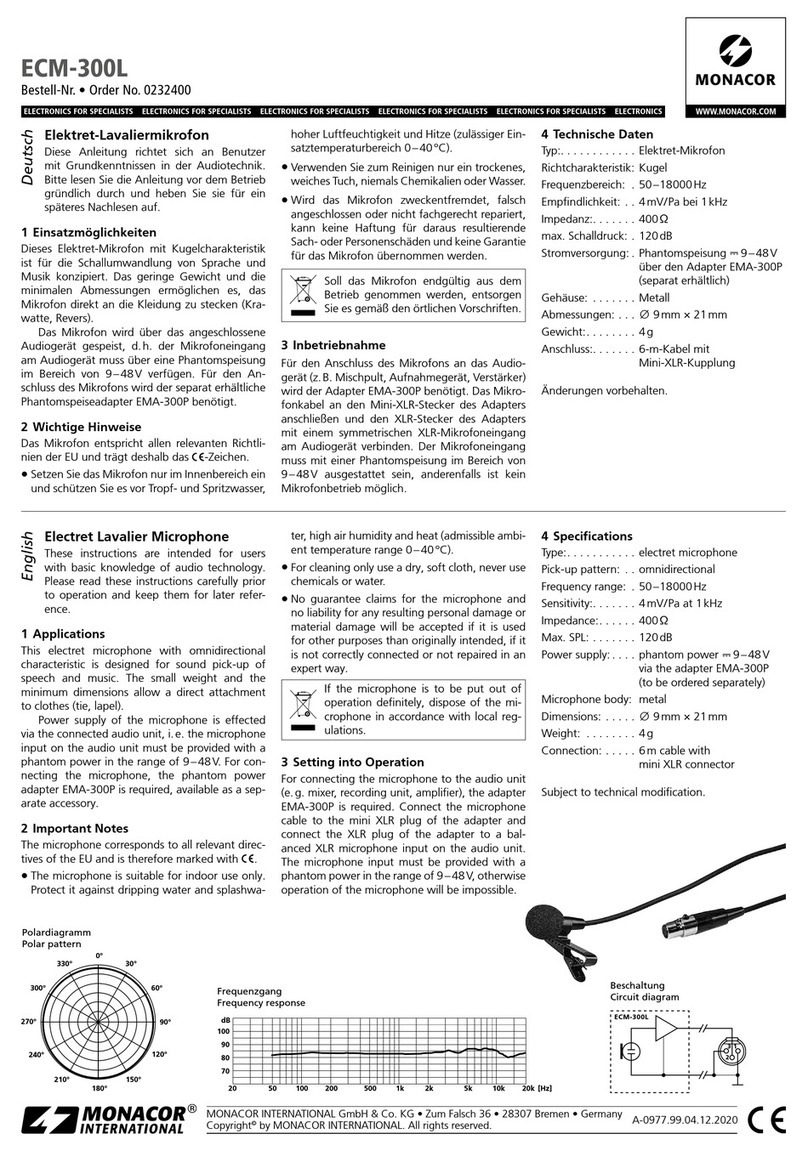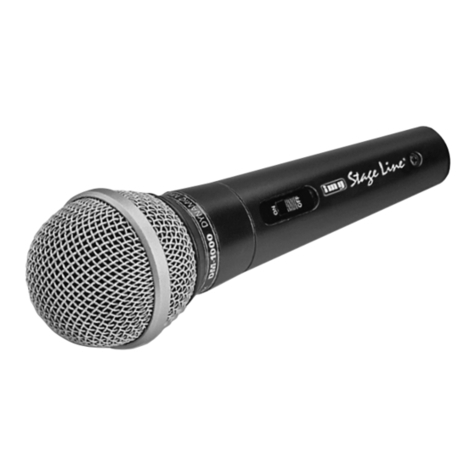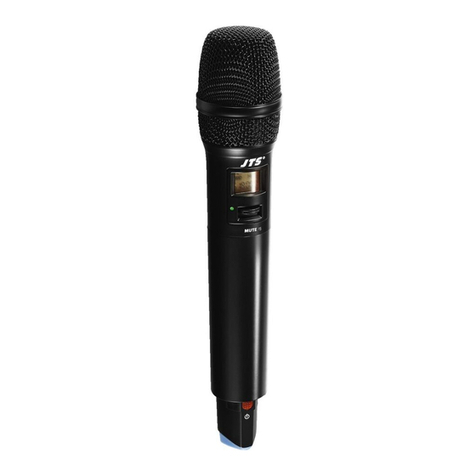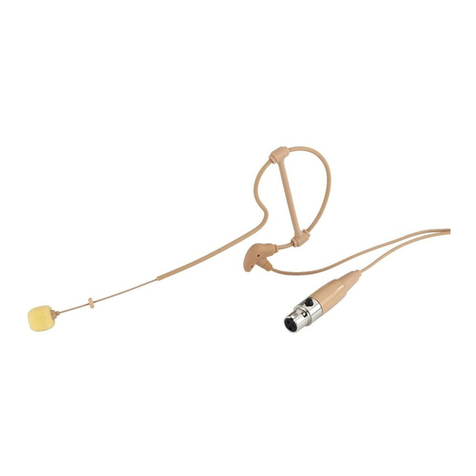ECM-401L
Best.-Nr. 23.3510
wwwwww..iimmggssttaaggeelliinnee..ccoomm
Copyright©by MONACOR INTERNATIONAL GmbH & Co. KG, Bremen, Germany. All rights reserved. A-0190.99.01.01.2004
®
ECM-402L
Best.-Nr. 23.3520
Elektret-Krawattenmikrofon
Einsatzmöglichkeiten
Die Elektret-Krawattenmikrofone ECM-401L und
ECM-402L mit sehr geringen Abmessungen sind
speziell für Sprachanwendungen konzipiert. Für
den Betrieb wird zusätzlich ein Speiseadapter (z.B.
EMA-40)oderein Taschensender(TXS-...HSE) von
„img Stage Line“ benötigt.
Hinweise für den sicheren Gebrauch
Das Mikrofon entspricht der EMV-Richtlinie für elek-
tromagnetische Verträglichkeit 89/336/EWG.
●Setzen Sie das Mikrofon nur im Innenbereich ein
und schützen Sie es vor Feuchtigkeit und Hitze
(zulässiger Einsatztemperaturbereich 0–40°C).
●VerwendenSiefürdie Reinigungnureintrockenes,
weiches Tuch, niemals Chemikalien oder Wasser.
●Wirddas Mikrofon zweckentfremdet,falsch ange-
schlossen oder nicht fachgerecht repariert, kann
keine Haftung für daraus resultierende Sach-
oder Personenschäden und keine Garantie für
das Mikrofon übernommen werden.
●Soll das Mikrofon endgültig aus dem Betrieb ge-
nommen werden, übergeben Sie es zur umwelt-
gerechtenEntsorgung einemörtlichen Recycling-
betrieb.
Inbetriebnahme
1) Die Mini-XLR-Kupplung des Mikrofonanschluss-
kabels auf den Mini-XLR-Anschluss des Taschen-
senders oder des Speiseadapters stecken. Bei
Verwendung eines Speiseadapters diesen an den
MikrofoneingangeinesAudiogerätes anschließen.
2) Das Mikrofon über seinen Klemmhalter an der
Kleidung befestigen (z.B. an der Krawatte oder
am Revers). Bei Bedarf lässt sich der Halter
abnehmen.
Technische Daten
Laut Angaben des Herstellers. Änderungen vorbehalten.
Electret Tie-clip Microphone
Applications
The electret tie-clip microphones ECM-401L and
ECM-402L with very small dimensions are es-
pecially designed for speech applications. For the
operation a power supply adapter (e.g. EMA-40) or
a pocket transmitter (TXS-...HSE) from “img Stage
Line” is additionally required.
Safety Notes
The microphone corresponds to the directive for
electromagnetic compatibility 89/336/EEC.
●The microphone is suitable for indoor use only.
Protect it against humidity and heat (admissible
ambient temperature range 0–40°C).
●For cleaning only use a dry, soft cloth, by no
means chemicals or water.
●No guarantee claims for the microphone or liabil-
ity for any resulting personal damage or material
damage will be accepted if the microphone is
used for other purposes than originally intended,
if it is not correctly connected, or not repaired in
an expert way.
●If the microphone is to be put out of operation de-
finitively, take it to a local recycling plant for a dis-
posal which is not harmful to the environment.
Setting the Microphone into Operation
1) Connect the mini XLR inline jack of the micro-
phone connection cable to the mini XLR connec-
tion of the pocket transmitter or power supply
adapter. When using a power supply adapter,
connectitto themicrophoneinputof anaudiounit.
2) Attach the microphone to your clothes (e.g. tie or
lapel) via its clip. If required, the clip can be re-
moved.
Specifications
According to the manufacturer. Subject to change.
Microphone cravate électret
Possibilités d’utilisation
Les microphones cravate électret ECM-401L et
ECM-402L de très petites dimensions sont spé-
cialement conçus pour des utilisations de discours.
Pour le fonctionnement, un adaptateur d’alimenta-
tion (p.ex. EMA-40) ou un émetteur de poche (TXS-
…HSE) de “img Stage Line” est en plus nécessaire.
Conseils d’utilisation et de sécurité
Le microphone répond à la norme européenne
89/336/CEE, relative à la compatibilité électroma-
gnétique.
●Le microphone n’est conçu que pour une utilisa-
tion en intérieur. Protégez le microphone de l’hu-
midité et de la chaleur (plage de température de
fonctionnement autorisée 0–40°C).
●Pour le nettoyer, utilisez uniquement un chiffon
sec et doux, en aucun cas de produits chimiques
ou d’eau.
●Nous déclinons toute responsabilité en cas de
dommages matériels ou corporels résultants si le
microphone est utilisé dans un but autre que celui
pour lequel il a été conçu, s’il n’est pas correcte-
ment branché ou s’il n’est pas réparé par une per-
sonne habilitée ; en outre, la garantie deviendrait
caduque.
●Lorsque le microphone est définitivement retiré
du circuit de distribution, vous devez le déposer
dans une usine de recyclage adaptée pour con-
tribuer à son élimination non polluante.
Mise en service
1) Placez la fiche mini XLR femelle du cordon de
branchement du micro dans la prise mini XLR de
l’émetteur de poche ou de l’adaptateur d’alimen-
tation. Si un adaptateur d’alimentation est utilisé,
reliez-le à l’entrée micro d’un appareil audio.
2) Fixez le micro via sa pince sur un vêtement (par
exemple sur la cravate ou sur un revers). Si
besoin, vous pouvez retirer la pince.
Caractéristiques techniques
D’après les données du constructeur.
Tout droit de modification réservé.
D
ECM-401L ECM-402L
Richtcharakteristik Kugel Niere
Frequenzbereich 20 – 20 000 Hz 70 – 15 000 Hz
Empfindlichkeit 10 mV/Pa /1 kHz 7mV/Pa /1 kHz
Impedanz 1,5 kΩ1,5 kΩ
Max. Schalldruck 110 dB 120 dB
Signal-Rausch-Abstand 63 dB 60 dB
Stromversorgung über Speiseadapter
Abmessungen Ø 7 mm x 18 mm Ø 7 mm x 22 mm
Anschluss 3-pol. Mini-XLR 3-pol. Mini-XLR
ACH
GB
FBCH
Pin DGB F
1Masse ground masse
2Audio audio audio
3Stromversorgung power supply alimentation
ECM-401L ECM-402L
Pick-up characteristic omnidirectional cardioid
Frequency range 20 – 20 000 Hz 70 – 15 000 Hz
Sensitivity 10 mV/Pa /1 kHz 7mV/Pa /1 kHz
Impedance 1.5 kΩ1.5 kΩ
Max. SPL 110 dB 120 dB
S/N ratio 63 dB 60 dB
Power supply via power supply adapter
Dimensions Ø 7 mm x 18 mm Ø 7 mm x 22 mm
Connection 3-pole mini XLR 3-pole mini XLR
ECM-401L ECM-402L
Directivité omnidirectionnel cardioïde
Bande passante 20 – 20 000 Hz 70 – 15 000 Hz
Sensibilité 10 mV/Pa /1 kHz 7mV/Pa /1 kHz
Impédance 1,5 kΩ1,5 kΩ
Pression sonore max. 110 dB 120 dB
Rapport signal/bruit 63 dB 60 dB
Alimentation par adaptateur alimentation
Dimensions Ø 7 mm x 18 mm Ø 7 mm x 22 mm
Branchements mini XLR 3 pôles mini XLR 3 pôles

